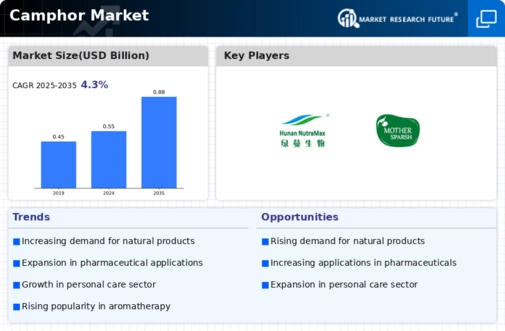Market Analysis
In-depth Analysis of Camphor Market Industry Landscape
The camphor market is subject to a variety of dynamic factors that influence both its supply and demand. Camphor, a natural organic compound derived from the wood of camphor trees or synthesized from turpentine oil, is widely used in various industries including pharmaceuticals, personal care, food and beverage, and industrial applications. The dynamics of this market are driven by factors such as global economic conditions, regulatory policies, technological advancements, and shifting consumer preferences.
One of the primary drivers of the camphor market is its extensive use in the pharmaceutical industry. Camphor is valued for its medicinal properties, including its analgesic, antiseptic, and anti-inflammatory properties. It is commonly used in topical ointments, balms, and liniments to relieve pain and inflammation associated with muscle aches, arthritis, and respiratory conditions. As the global population continues to grow and age, the demand for pharmaceutical products containing camphor is expected to rise, driving growth in the camphor market.
The camphor market is also influenced by regulatory policies related to product safety and quality. Camphor is classified as a drug by regulatory agencies in many countries, and its use in pharmaceutical products is subject to stringent quality control standards and regulatory approvals. Additionally, regulations governing the import, export, and sale of camphor products aim to ensure consumer safety and prevent the proliferation of counterfeit or adulterated products in the market. Compliance with regulatory requirements is essential for camphor manufacturers to maintain market access and consumer trust.
Technological advancements play a significant role in shaping the dynamics of the camphor market. Continuous innovation in extraction, purification, and synthesis techniques has led to the development of high-purity camphor products with enhanced quality and performance. Advanced manufacturing processes enable camphor producers to meet the growing demand for pharmaceutical-grade camphor and ensure consistency in product quality and purity. Moreover, research and development efforts focus on exploring new applications and formulations for camphor, expanding its market potential beyond traditional uses.
Market dynamics in the camphor industry are also influenced by global economic conditions and trade policies. Fluctuations in commodity prices, currency exchange rates, and trade tariffs can impact the cost of production and distribution of camphor products, affecting market supply and demand dynamics. Moreover, geopolitical tensions and trade disputes between major camphor-producing countries can disrupt supply chains and create market uncertainty.
Consumer preferences and trends also play a role in shaping the dynamics of the camphor market. As consumers become more health-conscious and seek natural alternatives to synthetic chemicals, there is growing demand for natural and plant-based products containing camphor. Manufacturers are responding to this trend by developing organic and eco-friendly camphor products to meet consumer demand for safe, sustainable, and environmentally friendly options. Additionally, changing lifestyles and preferences for aromatherapy and wellness products drive demand for camphor-based essential oils, candles, and diffusers.






Leave a Comment